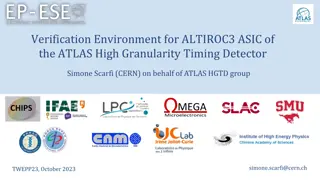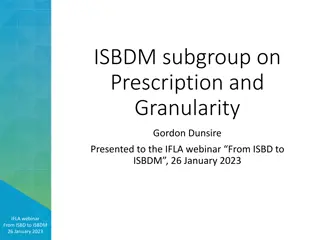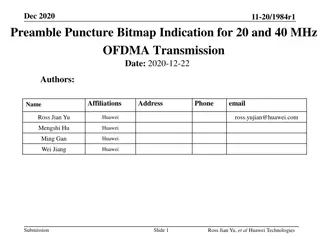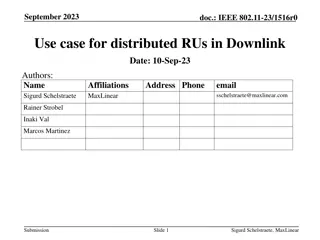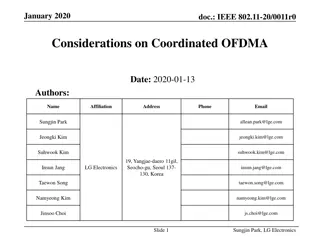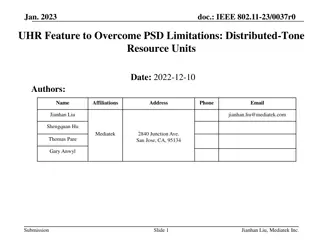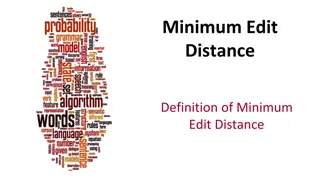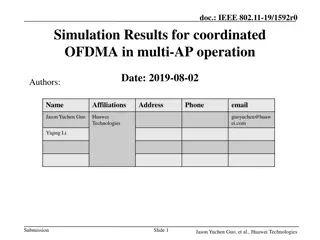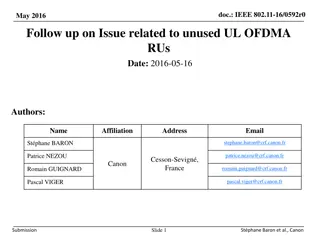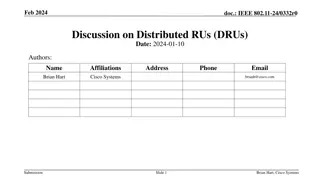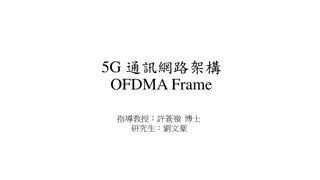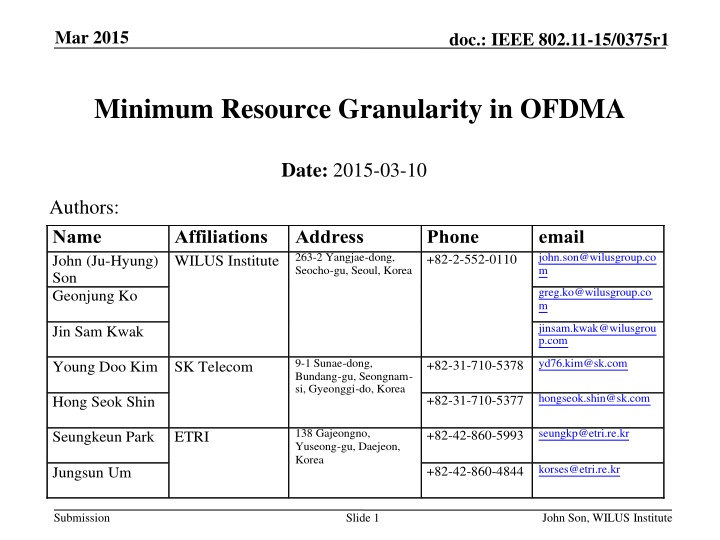
Resource Granularity in OFDMA: European Regulation Challenges
Explore the impact of European regulations on the utilization of sub-bands smaller than 5MHz in OFDMA technology. Learn about the requirements, bandwidth access rules, and possible options for using less than 5MHz sub-band in IEEE 802.11 standards. Addressing issues related to channel bandwidth, spectrum sharing, and compliance with ETSI standards.
Download Presentation

Please find below an Image/Link to download the presentation.
The content on the website is provided AS IS for your information and personal use only. It may not be sold, licensed, or shared on other websites without obtaining consent from the author. If you encounter any issues during the download, it is possible that the publisher has removed the file from their server.
You are allowed to download the files provided on this website for personal or commercial use, subject to the condition that they are used lawfully. All files are the property of their respective owners.
The content on the website is provided AS IS for your information and personal use only. It may not be sold, licensed, or shared on other websites without obtaining consent from the author.
E N D
Presentation Transcript
Mar 2015 doc.: IEEE 802.11-15/0375r1 Minimum Resource Granularity in OFDMA Date: 2015-03-10 Authors: Name John (Ju-Hyung) Son Geonjung Ko Affiliations WILUS Institute Address 263-2 Yangjae-dong, Seocho-gu, Seoul, Korea Phone +82-2-552-0110 email john.son@wilusgroup.co m greg.ko@wilusgroup.co m jinsam.kwak@wilusgrou p.com Jin Sam Kwak 9-1 Sunae-dong, Bundang-gu, Seongnam- si, Gyeonggi-do, Korea yd76.kim@sk.com +82-31-710-5378 Young Doo Kim SK Telecom +82-31-710-5377 hongseok.shin@sk.com Hong Seok Shin 138 Gajeongno, Yuseong-gu, Daejeon, Korea seungkp@etri.re.kr +82-42-860-5993 Seungkeun Park ETRI korses@etri.re.kr +82-42-860-4844 Jungsun Um Submission Slide 1 John Son, WILUS Institute
Mar 2015 doc.: IEEE 802.11-15/0375r1 Introduction IEEE 802.11 signal has always occupied at least 20MHz bandwidth. However, 11ax OFDMA may enable a STA to send a signal occupying a sub-band smaller than 20MHz. For frequency selective scheduling gains, the optimal size of sub-band depends on the coherence bandwidth of the channel models [1][2]. The 2.5MHz sub-band outperformed 5MHz in outdoor channel models [1]. In this contribution, we discuss European regulation issues that may conflict with the utilization of < 5MHz sub-band. Submission Slide 2 John Son, WILUS Institute
Mar 2015 doc.: IEEE 802.11-15/0375r1 European requirements on 5GHz unlicensed The European requirements on 5 GHz unlicensed spectrum deployment are specified in three ETSI harmonized standards [3][4][5]. EN 301 893 [3] applies to 5GHz RLAN equipment used in wireless local area networks in 5150~5350MHz and 5470~5725MHz. It describes spectrum access requirements to facilitate spectrum sharing with other equipment. EN 301 893(v1.7.1) was effective from June 2012, and the revised standard (currently draft v1.8.0) will be effective from June 2016 with mandatory compliance from June 2017 [6]. Submission Slide 3 John Son, WILUS Institute
Mar 2015 doc.: IEEE 802.11-15/0375r1 Bandwidth Access Rules in EN 301 893 (draft v1.8.0) [3] 4.3 Nominal Channel Bandwidth and Occupied Channel Bandwidth 4.3.1 Definition The Nominal Channel Bandwidth is the widest band of frequencies, inclusive of guard bands, assigned to a single channel. The Occupied Channel Bandwidth is the bandwidth containing 99 % of the power of the signal. ... 4.3.2 Limits The Nominal Channel Bandwidth shall be at least 5 MHz at all times. The Occupied Channel Bandwidth shall be between 80 % and 100 % of the declared Nominal Channel Bandwidth. In case of smart antenna systems (devices with multiple transmit chains) each of the transmit chains shall meet this requirement. During an established communication, the device is allowed to operate temporarily with an Occupied Channel Bandwidth below 80 % of its Nominal Channel Bandwidth with a minimum of 4 MHz. Nominal CH BW a 802.11 STA s operating CH BW (e.g. 20/40/80/160MHz in 11ac) >=5MHz Occupied CH BW a PPDU s occupying CH BW >=4MHz Therefore, a 802.11 STA shall not send a PPDU occupying less than 4MHz bandwidth. Submission Slide 4 John Son, WILUS Institute
Mar 2015 doc.: IEEE 802.11-15/0375r1 Possible options for utilization of < 5MHz Sub-band The regulation may affect UL OFDMA design where non-AP STAs transmit PPDUs within their own Sub-bands. If 11ax to utilize < 5MHz Sub-band for OFDMA, the following options can be considered. A. Distributed OFDMA Instead of localized subcarrier-based OFDMA, 11ax to adopt distributed subcarrier-based OFDMA. B. Asymmetric Downlink/Uplink design Allow AP to utilize < 5MHz sub-band for downlink, while non-AP STAs to utilize >= 5MHz sub-band for uplink. C. ETSI Regulation Modification Request ETSI TC BRAN to modify the EN 301 893 spec to allow operation with smaller Occupied CH BW. Submission Slide 5 John Son, WILUS Institute
Mar 2015 doc.: IEEE 802.11-15/0375r1 Option A. Distributed OFDMA Localized OFDMA Distributed OFDMA AP s Occupied CH BW=20MHz AP s Occupied CH BW=20MHz DL OFDMA DATA TX AP AP STA s Occupied CH BW=<5MHz (e.g., 2.5MHz) STA s Occupied CH BW 20MHz STA 1 STA 1 UL OFDMA DATA TX STA 2 STA 2 . . . . . . STA 8 STA 8 While Localized OFDMA assigns contiguous subcarriers to each STA, Distributed OFDMA assigns a set of distributed subcarriers to each STA. 11ax may choose the distributed OFDMA so that each STA s Occupied CH BW spans the Nominal CH BW. However, we need detailed analysis between two methods in terms of frequency selectivity/diversity gain and scheduling gain, etc. Submission Slide 6 John Son, WILUS Institute
Mar 2015 doc.: IEEE 802.11-15/0375r1 Option B. Asymmetric Downlink/Uplink design Downlink Uplink AP AP DL-OFDMA s Data or UL-OFDMA s Ack ... sub-band=Occupied BW>=4MHz sub-band UL-OFDMA s Data or DL-OFDMA s Ack UL-OFDMA s Data or DL-OFDMA s Ack Occupied BW>=4MHz ... ... STA 1 STA n STA 1 STA n Downlink (DL-OFDMA s Data or UL-OFDMA s Ack) AP can utilize < 5MHz sub-band for Data or Ack transmissions because the multiplexed sub-bands will occupy more than 4MHz Uplink (DL-OFDMA s Ack or UL-OFDMA s Data) STAs should not use sub-band based Ack with < 5MHz sub-band among various Ack methods for DL-OFDMA [7][8]. STAs should use sub-band size of >=4MHz for UL-OFDMA s Data. Submission Slide 7 John Son, WILUS Institute
Mar 2015 doc.: IEEE 802.11-15/0375r1 Option C. ETSI Regulation Modification In last year, 802.11 REG SC requested ETSI TC BRAN to modify the minimum size of the Occupied CH BW to accommodate 11ac s 160MHz operations that may utilize 20MHz occasionally. It is reflected in the current draft [9][10]. 11ax should first decide the size of OFDMA sub-band. If the < 5MHz sub-band is adopted, 11ax may propose a new work item (or modification request) to ETSI. However, ETSI TC BRAN is under voting for the final draft with the remaining WI for LBT section harmonization [11]. Submission Slide 8 John Son, WILUS Institute
Mar 2015 doc.: IEEE 802.11-15/0375r1 Conclusions While the minimum resource granularity with < 5MHz will provide higher scheduling gains in certain environments, less than 5MHz sub-band can not meet the current ETSI regulations on 5GHz unlicensed spectrums. We briefly discussed possible options to utilize < 5MHz sub-band, and those options or any other approaches require further discussions in 11ax. Submission Slide 9 John Son, WILUS Institute
Mar 2015 doc.: IEEE 802.11-15/0375r1 References [1] 11-14/1227r3, OFDMA Performance Analysis [2] 11-14/1452r0, Frequency selective scheduling in OFDMA [3] ETSI EN 301 893, Harmonized European Standard, Broadband Radio Access Networks (BRAN); 5 GHz high performance RLAN [4] ETSI EN 302 502, Harmonized European Standard, Broadband Radio Access Networks (BRAN); 5,8 GHz fixed broadband data transmitting systems [5] ETSI EN 302 571, Harmonized European Standard, Intelligent Transport Systems (ITS); Radio communications equipment operating in the 5 855 MHz to 5 925 MHz frequency band [6] 11-15/0149r0, Report from ETSI TC BRAN #81 [7] 11-14/1211r0, Ack Procedure for OFDMA [8] 11-14/1436r0, Overhead Analysis for Simultaneous Downlink Transmissions [9] 11-14/0511r0, ETSI BRAN regulatory test for occupied channel bandwidth and 802.11ac-2013 [10] ETSI TC BRAN(14)0000035, 802.11ac-2013 Partial Use of Bandwidth, Nominal Channel Bandwidth and Maskhttp://www.ieee802.org/11/private/ETSI_documents/BRAN/05- CONTRIBUTIONS/2014/2014_06_23_OR_BRAN%2380/BRAN(14)000035_802_11ac- 2013_Partial_Use_of_Bandwidth__Nominal_Channel_Band.doc [11] ETSI TC BRAN(14)0000087r5, Harmonized Standard Covering the essential requirement of Directive 2014/53/EUhttp://www.ieee802.org/11/private/ETSI_documents/BRAN/05- CONTRIBUTIONS/2014/BRAN(14)000087r5_Revision_of_EN_301_893_to_become_a_HS_under_the_new_RE- Direc.zip Submission Slide 10 John Son, WILUS Institute


